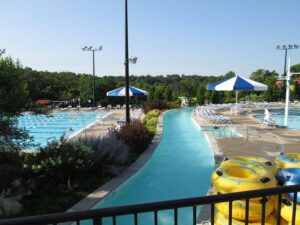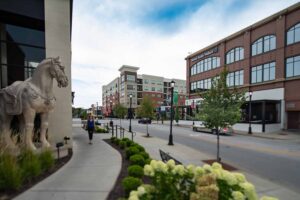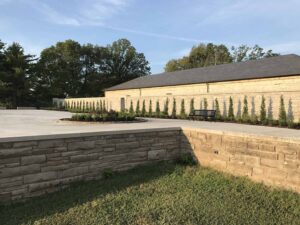Landscape Architecture involves far more than the selection of trees, shrubs, and plants. It is the design of environments for people, communities, plants, and animals. It encompasses all site types; from town squares, playgrounds, parks, and ponds, to school campuses, housing developments, and highways, to zoos and office plazas. In addition, landscape architects have a significant impact on the communities surrounding us. They are committed to the environment, incorporating sustainable designs to protect and conserve by prioritizing the use of native plant species suited to the local climate and soil conditions, integrating water-efficient design strategies such as permeable paving and bioswales, and incorporating energy-efficient tactics to reduce energy demands.
Key aspects of landscape architecture include:
-
Site Planning and Design: Landscape architects assess site conditions and develop design solutions that integrate natural and built elements, such as landforms, vegetation, water features, structures, and circulation patterns. They consider factors such as aesthetics, ecology, human use, accessibility, and cultural context.
-
Environmental Stewardship: Landscape architects apply principles of environmental sustainability to minimize the ecological footprint of designed landscapes and enhance ecosystem services. They strive to preserve and restore natural habitats, conserve water and energy, mitigate climate change impacts, and promote biodiversity.
-
Urban Design and Planning: Landscape architects contribute to the planning and design of urban environments, including streetscapes, plazas, waterfronts, and public spaces. They address issues related to urban sprawl, transportation, housing, social equity, and community resilience while fostering vibrant, livable, and inclusive cities.
-
Park and Recreation Design: Landscape architects design parks, playgrounds, sports facilities, and recreational amenities that provide opportunities for outdoor recreation, relaxation, and social interaction. They consider user needs, safety, accessibility, and programmatic requirements to create engaging and functional public spaces.
-
Land Development and Regeneration: Landscape architects play a role in land development projects, such as residential, commercial, and industrial developments, by integrating landscape design with site planning, infrastructure design, and land use zoning. They strive to balance development objectives with environmental conservation and community interests.
-
Historic Preservation: Landscape architects work to preserve and enhance historic landscapes, gardens, and cultural heritage sites, recognizing their significance as expressions of cultural identity, heritage, and collective memory. They employ research, documentation, conservation, and adaptive reuse strategies to safeguard these valuable resources.
Landscape Architecture is an incredibly collaborative profession. Cole has had the opportunity to creatively engage with a variety of professionals, including civil engineers within and outside of Cole, architects, mechanical engineers, lighting consultants, pool consultants, landscape architecture firms, institutions, private developers, municipalities, general contractors, lawyers, politicians, and professional athletes.

For 20 years, Cole’s planning and landscape architectural group has been building an impressive portfolio. The team had its start with an opportunity to master plan over 1000 single-family lots in Northwest Arkansas for a private developer. This early work has led to a comprehensive practice with licensure and experience in 30 states. Cole’s work now stretches across private and public development including education, parks, retail, commercial, mixed-use, residential, health care, and recreational. The group was part of a team awarded both a National Trust for Historic Preservation Award and a HUD Secretary’s Award for Excellence for the 14th Street Corridor Redevelopment in St. Louis, Missouri. Cole’s landscape architecture efforts for this collaborative mixed-use urban design project included streetscape design, park design, and parking lot layout.

Notable clients to date include Panera Bread, Taco Bell, Dunkin Donuts, the City of Lake Saint Louis, St. Louis County Parks, Great Rivers Greenway, Glendale Fire Department, City of St. Charles Fire Department, St. Louis County Police Department, City of Ferguson Fire Department, Forest Park Forever, City of Crestwood, Missouri, Sunset Hills, Missouri, a series of scenic regional libraries within the State of Missouri, Washington University in Saint Louis, Missouri University of Science and Technology, and multiple charter schools in the Carolina’s.

The Cole Planning and Landscape Architecture team is experienced and ready to solve your specific landscaping challenge. Visit colestl.com/services/landscape-architecture for more information or to connect with an expert today.
